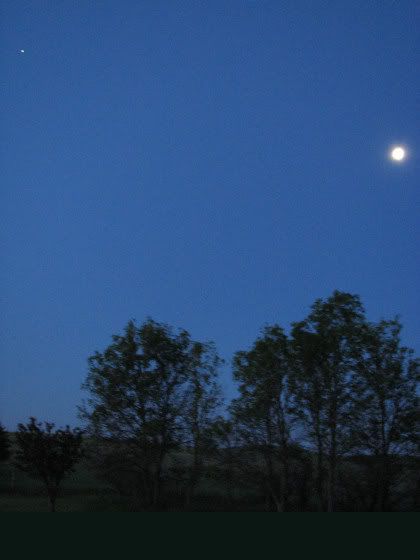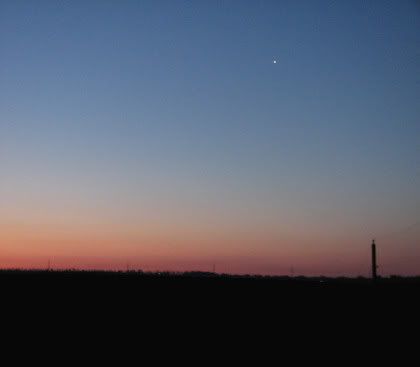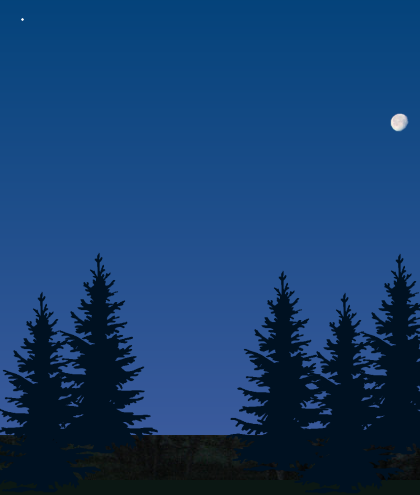Near civil twilight
A little after 5 a.m.
Clear sky.
One very bright prominent star/planet in eastern sky.
Moon (3/4 full?) is in the southern sky and one very bright prominent star/planet to the upper left of it.
Pumped up the ISO to 400 and took some pictures hand-held with my S3 point and shoot.
It was a tad difficult trying to get everything I needed in order to get a perspective on it. (Hilly in background, trees in front, but just the tops, so added a little more ground.)
Southern Sky:

Eastern Sky:

I adore this time of day.
Sky is lighting up on the horizon.
Birds are already singing.
The birth of a new day.
I searched online, but could not figure out what planets those were.
One place says Mars and Venus are together.
Nope, that's not it.
Another place says Jupiter is seen with the moon but at the lower left.
Nope, that's not it.
Nice illustrative pic here, though.
The moon looks like the right shape at least. ;)
Hey, I could do that, just make an illustration of what I saw...


I referred to my photos to get the placements correct. The only thing from the camera in the illustrations is the moon, which I took about an hour later. I wanted to show the shape of the moon more clearly than the original which glowed too much. The rest was created in Paint Shop Pro. I have an evergreen brush I used to paint the trees in. I don't really care for the sunrise gradient, but it's the closest to original I could get.
NOTES:
Dawn vs Dusk vs Twilight
Dawn = morning (before sunrise)
Dusk = evening (after sunset)
when noticeable amount of sunlight in the sky
Twilight = both
Morning twilight starts at dawn and ends with sunrise
Evening twilight starts with sunset and ends with dusk
Twilight - 3 Kinds
1. Civil Twilight
starts (morning) or ends (evening)
when the sun is 6 degrees below the horizon.
This is generally considered the limit of useable daylight.
2. Nautical Twilight
(aka Military Twilight)
starts or ends
when the sun is 12 degrees below the horizon.
Marks limits of unassisted human vision.
"first light"
"nightfall"
3. Astronomical Twilight
starts or ends
when the sun is 18 degrees below the horizon.
This marks the point at which there is no longer any detectable sunlight refracted in the atmosphere
REFERENCES/LINKS:
good-stuff UK
Sunrise, Sunset, Twilight and Dusk: FAQ
Twilight Definitions
Astronomical Applications Dept of U.S. Naval Observatory
Sunrise Sunset Table
Sun or Moon Rise/Set Table for One Year
Astronomical Applications Dept of U.S. Naval Observatory
Weather Underground
Weather and Twilight times by zip (search).
Wiki Twilight
IMAGE NOTES:
png file type gave better quality gradients than jpg file type.
Same or lower file size too.
Surprise.
I already knew gif's suck at gradients.
UPDATE: See post above this one for more moon pics.

No comments:
Post a Comment